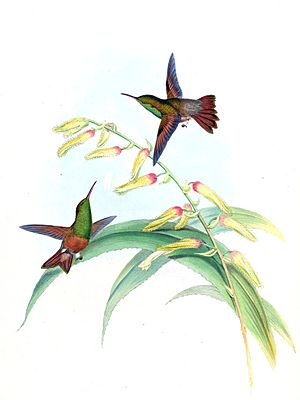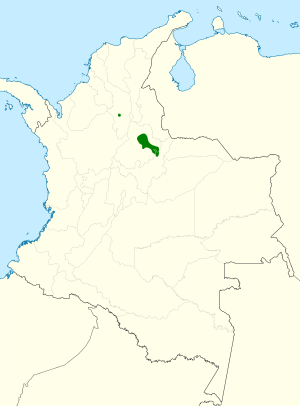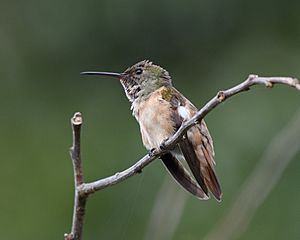Chestnut-bellied hummingbird facts for kids
Quick facts for kids Chestnut-bellied hummingbird |
|
|---|---|
 |
|
| Conservation status | |
| Scientific classification | |
| Genus: |
Saucerottia
|
| Species: |
castaneiventris
|
 |
|
| Synonyms | |
|
Amazilia castaneiventris |
|
The chestnut-bellied hummingbird (Saucerottia castaneiventris) is a beautiful little bird found only in Colombia. It's a type of hummingbird known as an "emerald" because of its shiny green feathers. Right now, it's considered a Near Threatened species, which means it needs our help to protect its home.
Contents
What's in a Name? The Chestnut-bellied Hummingbird's Taxonomy
Scientists like to group living things based on how they are related. This is called taxonomy. The chestnut-bellied hummingbird used to be in a group called Amazilia.
But in 2014, scientists used new ways to study birds, like looking at their DNA. They found that the Amazilia group wasn't quite right. So, they moved the chestnut-bellied hummingbird to a different group called Saucerottia.
This bird is also monotypic, which means it's the only species in its specific group.
Meet the Chestnut-bellied Hummingbird: Description
This hummingbird is about 9 cm (3.5 in) long. That's about the length of your palm!
Both male and female birds have a black beak. The bottom part of the beak is red.
The adult male has shiny bronze-green feathers on its back. Its tail is a pretty chestnut color. Its throat and upper chest are a bright, glittering green. The belly is a rich chestnut color, and the feathers under its tail are also chestnut with green edges.
The female looks similar to the male. Her belly is a bit lighter, and she has some white marks on her throat feathers. Young birds look like the female, but they have reddish-brown edges on the feathers of their neck and rump.
Where Do They Live? Distribution and Habitat
The chestnut-bellied hummingbird lives only in Colombia, a country in South America. It mostly lives in the drier parts of the Magdalena Valley.
You can find them in places like the Chicamocha, Suárez, and Chucurí River valleys. They prefer dry, brushy canyons. Sometimes, they are also seen at the lower edges of humid montane forest (mountain forests).
These birds are usually found at elevations between 500 and 1,500 m (1,600 and 4,900 ft) above sea level. However, they have been seen as low as 120 m (390 ft) and as high as 2,200 m (7,200 ft).
Scientists think they might move around during different seasons. This could be why they aren't always seen in the same places.
How Do They Live? Behavior
Seasonal Movements
Scientists believe that after the breeding season, these hummingbirds move from higher places down to lower areas. This might be to find more food or better weather.
What's on the Menu? Feeding Habits
We don't know all the details about how these hummingbirds find their food. But we do know they drink nectar from flowers like Salvia and Trichanthera.
Like many hummingbirds, they also eat small arthropods, which are tiny bugs. These bugs give them important protein.
Family Life: Breeding Habits
Scientists think the chestnut-bellied hummingbird's breeding season is from August to December. This is based on studies of the birds themselves.
However, we still don't know much about their breeding habits. For example, no one has ever found or described their nest!
What Do They Sound Like? Vocalization
The song of the chestnut-bellied hummingbird is quite unique! It's described as "a short, rhythmic phrase of three squeaky notes." Some people say it sounds like a rusty door-hinge, making sounds like 'krey-ki-cheep ... tsew ... krey-ki-cheep ...'.
They also make different calls. These include a slightly buzzy 'tzee', a high-pitched 'see', and a fast, high-pitched chattering sound.
Why Are They in Danger? Status and Threats
The IUCN (International Union for Conservation of Nature) keeps track of how endangered animals are. They have changed the status of the chestnut-bellied hummingbird several times. It was once considered Critically Endangered, but since 2019, it's been listed as Near Threatened.
There are an estimated 10,000 to 20,000 adult chestnut-bellied hummingbirds left. Sadly, their numbers are believed to be going down.
These hummingbirds live in a part of Colombia where many people also live. In recent years, there has been a lot of economic growth there. This includes a "gold rush" in 1996 and more logging (cutting down trees).
When forests are cut down, sugar and coffee farms often take their place. This means the hummingbirds lose their homes. More pollution and more people moving into the area also come with these new industries. While these businesses help Colombia's economy, they are the biggest threats to the chestnut-bellied hummingbird's habitat.




